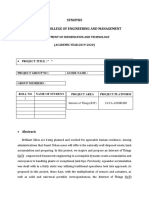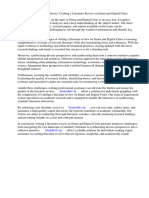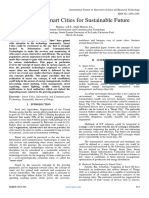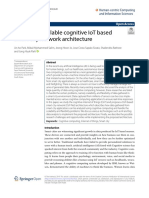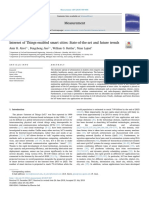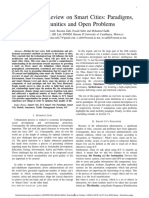Unlocking Smart City Potential: Machine Learning's Transformative Role
Unlocking Smart City Potential: Machine Learning's Transformative Role
Copyright:
Available Formats
Unlocking Smart City Potential: Machine Learning's Transformative Role
Unlocking Smart City Potential: Machine Learning's Transformative Role
Original Title
Copyright
Available Formats
Share this document
Did you find this document useful?
Is this content inappropriate?
Copyright:
Available Formats
Unlocking Smart City Potential: Machine Learning's Transformative Role
Unlocking Smart City Potential: Machine Learning's Transformative Role
Copyright:
Available Formats
Volume 8, Issue 9, September 2023 International Journal of Innovative Science and Research Technology
ISSN No:-2456-2165
Unlocking Smart City Potential:
Machine Learning’s Transformative Role
Teja Chalikanti1, Bobbili Sreeja Reddy2
1,2
Department of Computer Science and Engineering,
Guru Nanak Institutions Technical Campus, Ibrahipatnam, Telangana, India
Abstract:- This manuscript offers an extensive and smart cities in pursuit of these objectives. IoT devices, for
methodical literature review concerning the application instance, play a pivotal role in optimizing decisions aimed at
of machine learning (ML) methods in the burgeoning improving city services. Nevertheless, the incorporation of
field of smart cities. The review spans across vital smart IoT technologies into the fabric of smart cities has not been
city domains such as energy management, healthcare, without its downsides, including increased energy
transportation optimization, security enhancement, and consumption and heightened levels of pollution in the air,
pollution control. In this research, we present a cutting- soil, and water resources.
edge research methodology that introduces a state-of-
the-art taxonomy, evaluation framework, and model II. LITERATURE SURVEY
performance analysis, categorizing ML algorithms into
four principal classes: decision trees, support vector “A transparent and privacy-preserving healthcare
machines, artificial neural networks, and advanced platform with novel smart contract for smart cities.” By A.
machine learning techniques, encompassing hybrid A. Omar, A. K. Jamil, A. Khandakar, A. R. Uzzal, R. Bosri,
models, ensembles, and Deep Learning. Our study N. Mansoor, and M. S. Rahman [1]. Smart cities encompass
reveals that hybrid models and ensembles consistently various sectors like citizen safety, security, healthcare,
outperform other ML approaches, exhibiting a transportation, and energy, each requiring quality
maintenance. However, a pressing concern arises regarding
compelling combination of high accuracy and cost-
data privacy and security for Electronic Health Records
effectiveness. In contrast, deep learning (DL) techniques
showcase superior accuracy but demand substantial (EHR) due to constant cyber threats. Additionally, the
computational resources. Furthermore, all advanced ML integration of patients' financial data with EHRs for specific
methods exhibit relatively slower processing speeds insurance policies poses security risks from fraudulent
compared to single methods. Notably, support vector entities. Ensuring identity validation when interacting with
machines (SVM) and decision trees (DT) consistently different healthcare entities becomes challenging. The
outperform artificial neural networks (ANN) across proposed solution involves implementing a blockchain
various metrics. However, the margin of superiority is framework to safeguard patients' personal information and
negligible, suggesting that either SVM or DT may be insurance policies in the healthcare system. This blockchain
employed effectively depending on specific application integration, using the Ethereum platform, enhances data
requirements. privacy and security through cryptographic tools.
Ultimately, the aim is to address these challenges and
Keywords:- Smart cities, Machine Learning, Support vector provide a secure, transparent, and privacy-focused
machine, Decision Trees, Artificial Neural Network, urban healthcare environment within the smart city context.
sustainbility, Deep Learning, Single and Hybrid Models.
“Validation of IoT infrastructure for the construction
I. INTRODUCTION of smart cities solutions on living lab platform. “, by O. B.
Mora-Sanchez, E. Lopez-Neri, E. J. Cedillo-Elias, E.
Inhabitants of urban centers have witnessed a dramatic Aceves-Martinez, and V. M. Larios. [2], By In this paper, it
shift in the way they live, work, and interact due to the revolves around the escalating use of Internet-of-Things
proliferation of resources and amenities. A profound (IoT) applications in the real world, particularly within the
transformation in urban living has emerged, with more than context of smart cities. It emphasizes the crucial role of
half of the global population now residing in cities. networked IoT devices in gathering data from the physical
However, the term "smart city" remains somewhat elusive, environment to enhance city services for citizens. To
and its definition varies across regions. In this research evaluate the effectiveness of these solutions, the text
paper, we establish a clear understanding of a smart city as mentions the utilization of living labs as a valuable
one that harnesses Information and Communication approach, although it acknowledges that many real-world
Technologies (ICT) to enhance the quality of life for its implementations often fall short in matching the complexity
citizens, tackle urban challenges (such as pollution, traffic of actual smart cities. The article proposes a methodology
congestion, and crime), and conserve its natural resources. aimed at validating the scalability of IoT infrastructure,
The concept of smart cities is intrinsically linked to focusing on key properties such as modularity,
aspirations of elevating living standards, expanding service interoperability, and resiliency. These properties are
provisions, and achieving social sustainability. essential for IoT systems to effectively meet the demands
Consequently, a range of technologies, including the and complexities of smart cities. The methodology is
Internet of Things (IoT), Big Data analytics, and Cloud derived from best practices observed during the
Computing, have been enlisted as essential tools to empower implementation of a living lab at the Smart Cities Innovation
IJISRT23SEP247 www.ijisrt.com 286
Volume 8, Issue 9, September 2023 International Journal of Innovative Science and Research Technology
ISSN No:-2456-2165
Center in the Universidad de Guadalajara. Ultimately, the III. METHODOLOGY
text underscores the importance of scalable and adaptable
IoT infrastructure in realizing the potential of smart cities. The objective of this project is to systematically
categorize and arrange machine learning techniques
“Municipalities’ understanding of the smart city employed in smart city applications into four distinct
concept: An exploratory analysis in Belgium” by J. architectural categories: single models, hybrid models,
Desdemoustier, N. Crutzen, and R. Giffinger [3], This paper ensemble models, and Deep Learning (DL).
explores the multifaceted nature of the Smart City concept,
recognizing its complexity and the challenges it poses in This project introduces an innovative taxonomy that
academic discourse. Two key issues are identified: the shifts the focus from categorizing ML techniques based on
dominant technocentric perspective and the central role of specific smart city applications to classifying them
private companies in shaping Smart Cities. Furthermore, the according to their fundamental algorithms and approaches.
absence of a well-defined conceptual framework has led This novel taxonomy is intended to serve as a valuable
many cities to claim themselves as 'smart' without clear resource for researchers, policymakers, and practitioners,
criteria. The lack of rigorous analytical or statistical analyses aiding them in selecting the most appropriate ML tools to
further compounds the ambiguity surrounding the concept's enhance the quality of life in smart cities.
application in different territories. The study focuses on
Belgian municipalities in 2016, aiming to understand their The remainder of this paper is structured as follows:
perceptions of Smart Cities. Drawing from existing Section II provides an in-depth explanation of our research
literature and a survey of 113 Belgian municipalities, the methodology for conducting this comprehensive literature
paper outlines a typology encompassing four distinct review. In Section III, we delve into the existing literature,
understandings of Smart Cities: technological, societal, highlighting the pivotal role played by state-of-the-art ML
comprehensive, and non-existent. The findings reveal a algorithms in addressing various challenges within smart
geographical and conceptual divide. Small and rural cities. Additionally, this section presents the taxonomy of AI
municipalities often lack a clear understanding of the Smart and ML-based techniques that can be applied to various
City concept or adopt a technical view, potentially aspects of smart city development.
indicating skepticism or rejection of the phenomenon. In A. Existing System:
contrast, medium and large-sized municipalities tend to
Smart city networks encompass a multitude of
embrace a more societal or comprehensive understanding,
applications, each with distinct Quality of Service (QoS)
demonstrating a greater acceptance of Smart City principles.
demands, making network management a complex task.
“Designing smart city mobile applications: An initial Efforts to ensure QoS support have yet to be extensively
grounded theory.” By R. S. Farias, R. M. de Souza, J. D. implemented in large-scale networks. Traffic
McGregor, and E. S. de Almeid [4], This text underscores classification is a strategy employed to address various
the pivotal role of the software architecture community in concerns, including meeting QoS prerequisites.
shaping the landscape of mobile software development. However, traditional traffic classification techniques like
Traditional software architecture concepts have been the port-based approach are inadequate due to their
instrumental in the evolution of mobile computing, incapacity to adapt to dynamic port allocation and
contributing significantly to its widespread adoption. encryption.
However, mobile applications within the framework of The utilization of machine learning for traffic
smart cities present unique challenges. These challenges classification has garnered significant attention within
encompass the need to operate within the constraints of research circles as an alternative approach for achieving
mobile devices, adhere to rigorous smart city requirements, superior performance. Machine learning injects
and navigate a dynamic and often untrusted environment. intelligence into network functions, thereby enhancing
Given the absence of widely accepted design models for network management capabilities. Within this research,
such software, developers often resort to rudimentary design we employ machine learning algorithms to forecast
decisions, necessitating additional time and expertise. network traffic classification. Our assessment outcomes
Consequently, this study aims to delve into the design reveal that, among the algorithms scrutinized, the
process for mobile applications in smart city contexts. To decision tree algorithm consistently delivers the highest
address the dearth of verified information on designing average accuracy.
mobile apps, a multi-case study involving nine applications
B. Decision Tree:
from four development groups was conducted. These
applications were reverse engineered to uncover their In classification tasks, machine learning models predict
architecture, followed by interviews with their developers. predefined categorical class labels, while in regression,
The study culminated in the creation of a grounded theory, they forecast continuous outputs. The process in
elucidating how the selected design process yields supervised learning encompasses training and testing
applications with the desired characteristics. This theory phases. In this study, we conduct a comparative analysis,
offers valuable insights into how software engineering teams pitting the Decision Tree (DT) algorithm against
design mobile apps for smart cities, serving as a foundation approaches similar to those in previous studies. For
for improved understanding, more effective design example, another study proposed a Deep Learning (DL)
practices, and enhanced development process definitions in method comprising five hidden layers and 10 hidden
this evolving domain. nodes for the same dataset. Our model, however,
IJISRT23SEP247 www.ijisrt.com 287
Volume 8, Issue 9, September 2023 International Journal of Innovative Science and Research Technology
ISSN No:-2456-2165
outperformed the DL method, achieving notably higher variables and selects the split that yields the most
accuracy compared to other models in the evaluation. homogeneous sub-nodes.
Decision trees employ a variety of algorithms to Furthermore, it's worth noting that decision trees are
determine when to split a node into two or more sub- renowned for their interpretability, making them a
nodes. This partitioning of nodes enhances the valuable tool not only for accurate predictions but also
uniformity or "purity" of the resulting sub-nodes for comprehending the factors that contribute to those
concerning the target variable. Put simply, decision trees predictions. This attribute sets them apart as a
aim to maximize the homogeneity within sub-nodes. To transparent and insightful choice within the realm of
achieve this, the decision tree explores all available machine learning algorithms.
Fig. 1: Working of Decision Tree
C. Disadvantages: In terms of accuracy and other essential metrics, support
They are largely unstable compared to other decision vector machines (SVM) and decision trees (DT)
predictors. consistently outperform artificial neural networks
A small change in the data can result in a major change (ANN). However, the performance differences among
in the structure of the decision tree. SVM, DT, and ANN are relatively small. Consequently,
Overfitting problem will occur. we can conclude that selecting any of these methods is
justifiable based on the specific requirements and
D. Proposed System: constraints of a given smart city application.
In this section, we delve into the utilization of machine
learning (ML) methods within the context of smart cities, E. Techniques or Algorithms used:
considering various perspectives. Drawing upon the
insights gathered from our survey, we undertake a Support Vector Machine (SVM):
comprehensive analysis to gauge how these methods Classification and Prediction: SVM is a powerful
compare across key performance criteria, encompassing algorithm for both classification and prediction tasks in
efficiency (measured in terms of processing time), smart cities. In classification, SVM is used to categorize
reliability (assessed through result accuracy), and other data points into predefined classes, which can be
pertinent performance dimensions. It becomes evident incredibly valuable for various applications like traffic
that hybrid models and ensembles stand out as the top- management, security, and healthcare. For prediction,
performing choices within this domain. These models SVM can forecast values such as energy consumption
strike an effective balance, offering both high accuracy or pollution levels based on historical data, aiding in
and manageable complexity, making them well-suited resource optimization.
for addressing the multifaceted challenges presented by Efficient Class Separation: SVM is skilled at finding the
smart cities. most effective hyperplanes that separate different
On the contrary, while deep learning (DL) techniques classes of data in the feature space. In a smart city
consistently demonstrate superior accuracy when context, this translates to efficiently distinguishing
compared to hybrid models and ensembles, they do come between various states or conditions like safe/unsafe
with a trade-off. DL methods require considerably higher areas, traffic congestion levels, or environmental
computational resources, which can pose limitations in quality.
resource-constrained scenarios. Additionally, it's Robustness: SVM is known for its robustness in
noteworthy that all advanced ML techniques generally handling complex data distributions and is less prone to
exhibit slower processing speeds in contrast to single- overfitting, making it reliable for real-world
method approaches. applications. In smart cities, where data can be noisy
and dynamic, SVM's stability is advantageous.
IJISRT23SEP247 www.ijisrt.com 288
Volume 8, Issue 9, September 2023 International Journal of Innovative Science and Research Technology
ISSN No:-2456-2165
Fig. 2: SVM Classification
Fig. 3: SVM-Kernel
Decision Tree: Artificial Neural Networks (ANN):
Transparent Decision-Making: Decision trees provide a Complex Pattern Recognition: ANNs are well-suited for
transparent and interpretable model for decision-making smart cities due to their ability to recognize complex
in smart cities. They partition data into segments based patterns and relationships in data. This makes them
on the most informative features, allowing city planners valuable for applications like predictive maintenance of
and policymakers to understand the factors influencing city infrastructure, optimizing energy grids, and
specific outcomes. analyzing urban growth trends.
Scenario-based Decisions: DTs can be customized to Scalability: Deep Neural Networks (DNNs), a subset of
reflect various scenarios or conditions within a smart ANNs, can handle vast amounts of data and intricate
city. For example, decision trees can help decide the architectures. In smart cities, where data streams are
most efficient transportation routes, taking into account abundant from sensors and IoT devices, DNNs can
factors like traffic congestion, air quality, and energy efficiently process and analyze these data sources.
consumption. Real-time Decision Support: ANNs can provide real-
Adaptability: Decision trees can adapt to evolving time decision support for various aspects of a smart
conditions, making them suitable for dynamic smart city, such as traffic management, healthcare monitoring,
city environments. They can continuously evaluate and and emergency response. They can process data quickly
adjust decision criteria to respond to changing and deliver insights that enable timely actions.
circumstances.
IJISRT23SEP247 www.ijisrt.com 289
Volume 8, Issue 9, September 2023 International Journal of Innovative Science and Research Technology
ISSN No:-2456-2165
Fig. 4: ANN overview
F. Advantages: It could learn and model non-linear and complex
Effective in high dimensional spaces. relationships.
It works well with a clear margin of separation. It is Able to handle both numerical and categorical data.
effective in high dimensional spaces.
G. System Architecture:
Fig. 5: System Architecture
In this project, we have designed following modules. Data Preparation:
In this phase, we engage in data wrangling to make it
Data Gathering: suitable for model training. This includes tasks like data
The initial and essential phase in the progression of cleaning (removing duplicates, rectifying errors, handling
building a machine learning model involves collecting data. missing values, normalization, and data type conversions).
This pivotal step significantly impacts the model's overall We also randomize the data to eliminate any potential biases
performance; the quality and quantity of data acquired arising from the data collection order. Data visualization is
directly influence the model's effectiveness. Various employed to identify relevant relationships between
methods can be employed to gather data, including web variables, address class imbalances, and conduct exploratory
scraping, manual interventions, and more. These techniques analysis. Subsequently, the data is divided into training and
play a crucial role in advancing the capabilities of machine evaluation sets.
learning models within the context of enhancing smart
cities, as explored in this comprehensive literature review.
IJISRT23SEP247 www.ijisrt.com 290
Volume 8, Issue 9, September 2023 International Journal of Innovative Science and Research Technology
ISSN No:-2456-2165
Model Selection: Accuracy on the Test Set:
Our choice of algorithm for this project was the Support Our model yielded an impressive 89% accuracy on the
Vector Machine (SVM). We opted for SVM due to test set, indicating its robust performance.
achieving an 89% accuracy rate on the training set,
justifying its implementation. Saving the Trained Model:
When transitioning the trained and tested model to a
Analysis and Prediction: production-ready environment, the initial step involves
Deep learning techniques involve the utilization of pre- saving it in a .h5 or .pkl file format. We utilize libraries like
trained deep learning models for feature extraction. These pickle for this task, ensuring that the necessary modules are
pre-trained models undergo fine-tuning specific to the installed in the environment. Subsequently, we import the
phishing detection task to enhance model accuracy. module and save the model into a .pkl file for future use.
H. Output Snapshots:
Fig. 6: Welcome Page
Fig. 7: Admin login Page
Fig. 8: After logged in
IJISRT23SEP247 www.ijisrt.com 291
Volume 8, Issue 9, September 2023 International Journal of Innovative Science and Research Technology
ISSN No:-2456-2165
Fig. 9: Display to enter manager details
Fig. 10: Enter robot details
Fig. 11: Enter the details of robot
Fig. 12: Enter production details
IJISRT23SEP247 www.ijisrt.com 292
Volume 8, Issue 9, September 2023 International Journal of Innovative Science and Research Technology
ISSN No:-2456-2165
Fig. 13: Display page of smart industry
Fig. 14: Login Page
Fig. 15: Enter user login credentials
Fig. 16: Uploading the file
IJISRT23SEP247 www.ijisrt.com 293
Volume 8, Issue 9, September 2023 International Journal of Innovative Science and Research Technology
ISSN No:-2456-2165
Fig. 17: File has uploaded
Fig. 18: Preview page
Fig. 19: displaying the dataset
Fig. 20: Displaying parameters
IJISRT23SEP247 www.ijisrt.com 294
Volume 8, Issue 9, September 2023 International Journal of Innovative Science and Research Technology
ISSN No:-2456-2165
Fig. 21: The specific values of parameters are entered
Fig. 22: Prediction of spam
Fig. 23: Performance
Fig. 24: Correlation Analysis
IV. CONCLUSION
For each of these machine learning algorithms, we
In this study, we have conducted a comprehensive and have provided theoretical descriptions and highlighted their
systematic review of machine learning algorithms within the diverse applications in the smart city domain. Additionally,
context of smart city applications. Our findings categorize we have conducted a thorough evaluation of these
machine learning algorithms into four primary groups: algorithms, considering factors such as computational speed,
decision trees, support vector machines, artificial neural output accuracy, and their respective strengths and
networks, and advanced machine learning methods, weaknesses.
including hybrid approaches, ensembles, and deep learning
techniques.
IJISRT23SEP247 www.ijisrt.com 295
Volume 8, Issue 9, September 2023 International Journal of Innovative Science and Research Technology
ISSN No:-2456-2165
V. FUTURE ENHANCEMENT
In the upcoming years, we anticipate a growing trend
of integrating IoT technology with increasingly robust and
dependable machine learning algorithms. This synergy will
enable the efficient processing of vast datasets gathered
from sensors, paving the way for innovative solutions to
address critical urban challenges including traffic
management, healthcare, pollution control, and education.
REFERENCES
[1.] C. Perera, A. Zaslavsky, P. Christen, and D.
Georgakopoulos, ‘‘Sensing as a service model for
smart cities supported by Internet of Things,’’ Trans.
Emerg. Telecommun. Technol., vol. 25, no. 1, pp.
81–93, Jan. 2014.
[2.] J. Desdemoustier, N. Crutzen, and R. Giffinger,
‘‘Municipalities’ understanding of the smart city
concept: An exploratory analysis in Belgium,’’
Technol. Forecasting Social Change, vol. 142, pp.
129–141, May 2019.
[3.] J. Edelenbos, F. Hirzalla, L. van Zoonen, J. van
Dalen, G. Bouma, A. Slob, and A. Woestenburg,
‘‘Governing the complexity of smart data cities:
Setting a research agenda,’’ in Smart Technologies
for Smart Governments. Cham, Switzerland:
Springer, 2018.
[4.] R. S. Farias, R. M. de Souza, J. D. McGregor, and E.
S. de Almeida, ‘‘Designing smart city mobile
applications: An initial grounded theory,’’ Empirical
Softw. Eng., vol. 24, no. 6, pp. 3255– 3289, Dec.
2019.
[5.] R. Carli, M. Dotoli, and R. Pellegrino, ‘‘ICT and
optimization for the energy management of smart
cities: The street lighting decision panel,’’ in Proc.
IEEE 20th Conf. Emerg. Technol. Factory Autom.
(ETFA), Sep. 2015.
[6.] K. H. Law and J. P. Lynch, ‘‘Smart city:
Technologies and challenges,’’ IT Prof., vol. 21, no.
6, pp. 46–51, Nov. 2019.
[7.] R. Giffinger and H. Gudrun, ‘‘Smart cities ranking:
An effective instrument for the positioning of the
cities?’’ Archit., City Environ., vol. 4, no. 12, pp. 7–
26, 2010.
[8.] V. P. Shrivastava and J. Singh, ‘‘‘Smart city’
definition ITS practice in India,’’ Int. J. Recent
Technol. Eng., vol. 8, no. 4, pp. 43–53, 2019.
[9.] H. Vasudavan, S. S. Gunasekaran, and S.
Balakrishnan, ‘‘Smart city: The state of the art,
definitions, characteristics and dimensions,’’ J.
Comput. Theor. Nanosci., vol. 16, no. 8, pp. 3525–
3531, Aug. 2019.
[10.] A. A. Omar, A. K. Jamil, A. Khandakar, A. R. Uzzal,
R. Bosri, N. Mansoor, and M. S. Rahman, ‘‘A
transparent and privacy-preserving healthcare
platform with novel smart contract for smart cities,’’
IEEE Access, vol. 9, pp. 90738–90749, 2021.
IJISRT23SEP247 www.ijisrt.com 296
You might also like
- Introduction To Juniper Security (IJSEC)Document3 pagesIntroduction To Juniper Security (IJSEC)Djamel-Eddine toubalNo ratings yet
- Machine Learning A Way To Smart EnvironmentDocument7 pagesMachine Learning A Way To Smart EnvironmentInternational Journal of Innovative Science and Research TechnologyNo ratings yet
- Synopsis G.H.Raisoni College of Engineering and ManagementDocument11 pagesSynopsis G.H.Raisoni College of Engineering and ManagementPruthviraj SuradkarNo ratings yet
- Privacy in The Smart City-Applications, Technologies, Challenges, and SolutionsDocument28 pagesPrivacy in The Smart City-Applications, Technologies, Challenges, and SolutionsEladhio BurgosNo ratings yet
- Berkel 2018Document18 pagesBerkel 2018Carolina RoblesNo ratings yet
- Smart City Paper 4Document34 pagesSmart City Paper 4K Bhavish V SuvarnaNo ratings yet
- I-Smacp: Iot Smart City PlanningDocument13 pagesI-Smacp: Iot Smart City Planningvenkata sivaiahNo ratings yet
- Smart and Digital City A Systematic Literature ReviewDocument5 pagesSmart and Digital City A Systematic Literature Reviewea68afjeNo ratings yet
- Smart Technologies For Smart Nations Internet of ThingsDocument6 pagesSmart Technologies For Smart Nations Internet of ThingsInternational Journal of Innovative Science and Research TechnologyNo ratings yet
- Characterization and Efficient ManagemenDocument29 pagesCharacterization and Efficient ManagemendigitalromNo ratings yet
- Sensors 23 08753 With CoverDocument16 pagesSensors 23 08753 With Coverrdlf coverNo ratings yet
- Smart City Master ThesisDocument8 pagesSmart City Master Thesissaraharrismilwaukee100% (2)
- A Survey: Smart Cities For Sustainable FutureDocument4 pagesA Survey: Smart Cities For Sustainable FutureInternational Journal of Innovative Science and Research TechnologyNo ratings yet
- Access Control For Smart CitiesDocument40 pagesAccess Control For Smart CitiesFernando SpistoNo ratings yet
- Role of IoT-Cloud Ecosystem in Smart Cities Review and ChallengesDocument5 pagesRole of IoT-Cloud Ecosystem in Smart Cities Review and ChallengesRANGGA BAGASKARANo ratings yet
- Real Time Iot Stream Processing and Large-Scale Data Analytics For Smart City ApplicationsDocument5 pagesReal Time Iot Stream Processing and Large-Scale Data Analytics For Smart City ApplicationsSureshNo ratings yet
- The Role of Small Cell Technology in Future Smart City ApplicationsDocument11 pagesThe Role of Small Cell Technology in Future Smart City ApplicationsVigilante Samuel Hanson HaganNo ratings yet
- Ciot Net: A Scalable Cognitive Iot Based Smart City Network ArchitectureDocument20 pagesCiot Net: A Scalable Cognitive Iot Based Smart City Network ArchitectureHNI CNTTNo ratings yet
- Internet of Things-Enabled Smart Cities. State-Of-The-Art and Future TrendsDocument18 pagesInternet of Things-Enabled Smart Cities. State-Of-The-Art and Future TrendsJanneth TQNo ratings yet
- Sensors 24 02074 v4Document36 pagesSensors 24 02074 v4JUHINo ratings yet
- Sustainable Cities and Society: A B C D e FDocument27 pagesSustainable Cities and Society: A B C D e FSathish LakshmikanthanNo ratings yet
- A Literature Review On Smart Cities - Paradigms, Opportunities and Open ProblemsDocument7 pagesA Literature Review On Smart Cities - Paradigms, Opportunities and Open Problemsdrive1nshaneeNo ratings yet
- Building Smart CitiesDocument6 pagesBuilding Smart Citiespsana99gmailcomNo ratings yet
- Dryjanski 2020Document6 pagesDryjanski 2020Nesthug PcNo ratings yet
- A Bayesian Machine Learning Approach For Smart CityDocument23 pagesA Bayesian Machine Learning Approach For Smart CityIJRASETPublicationsNo ratings yet
- Measurements of Spatial Angles Using Diamond Nitrogen-Vacancy Center Optical Detection Magnetic ResonanceDocument5 pagesMeasurements of Spatial Angles Using Diamond Nitrogen-Vacancy Center Optical Detection Magnetic Resonancekiroya8145No ratings yet
- Augmented Reality AR and CyberSecurity For Smart CitiesA Systematic Literature ReviewSensorsDocument17 pagesAugmented Reality AR and CyberSecurity For Smart CitiesA Systematic Literature ReviewSensorsDinesh Kumar RNo ratings yet
- Iot Smart City Literature ReviewDocument4 pagesIot Smart City Literature ReviewMahimaNo ratings yet
- Artificial Intelligence Technologies and Related Urban Planning and Development Concepts How Are They Perceived and Utilized in AustraliaDocument21 pagesArtificial Intelligence Technologies and Related Urban Planning and Development Concepts How Are They Perceived and Utilized in Australiahusnul hayyahNo ratings yet
- The Role of An Information and Communication Technology in Smart CityDocument9 pagesThe Role of An Information and Communication Technology in Smart CityIJRASETPublicationsNo ratings yet
- A Review on Deep Learning for Future Smart CitiesDocument6 pagesA Review on Deep Learning for Future Smart CitiesnshNo ratings yet
- 1 s2.0 S2210670717311125 MainDocument17 pages1 s2.0 S2210670717311125 MainMOHD TARIQ AZEEMNo ratings yet
- Smart Cities and NICT: Alami Sara, Hanoune Mostafa, Benzrioual SouhailDocument4 pagesSmart Cities and NICT: Alami Sara, Hanoune Mostafa, Benzrioual SouhailEditor IJRITCCNo ratings yet
- Future Challenges For Smart Cities Cyber Security and Digital ForensicsDocument11 pagesFuture Challenges For Smart Cities Cyber Security and Digital ForensicskottagattuakhiNo ratings yet
- Big Data Smart CitiesDocument52 pagesBig Data Smart CitieszeroxtNo ratings yet
- A Blockchain-Based Architecture and Framework ForDocument12 pagesA Blockchain-Based Architecture and Framework ForMiltiadis LytrasNo ratings yet
- 2022 Large-Scale Modeling and Analysis of Uplink and Downlink Channels For LoRa Technology in Suburban EnvironmentsDocument15 pages2022 Large-Scale Modeling and Analysis of Uplink and Downlink Channels For LoRa Technology in Suburban EnvironmentsinspectorjavertNo ratings yet
- Human-Centric_Digital_Twins_inDocument28 pagesHuman-Centric_Digital_Twins_inshivangi.garg8169No ratings yet
- Smartcities 07 00057Document44 pagesSmartcities 07 00057Ashish RauniyarNo ratings yet
- Smart City:: A Case of SeoulDocument14 pagesSmart City:: A Case of SeoulFebby MellianiNo ratings yet
- Iii Bca and CS Iot Notes 2023 PDFDocument105 pagesIii Bca and CS Iot Notes 2023 PDFsp2392546No ratings yet
- 07 - Cretu PDFDocument11 pages07 - Cretu PDFIsabella Velasquez RodriguezNo ratings yet
- IJCST V4I2P57 With Cover Page v2Document7 pagesIJCST V4I2P57 With Cover Page v2MO 2004No ratings yet
- Convergence of Blockchain and Artificial Intelligence in IoT NetworkDocument16 pagesConvergence of Blockchain and Artificial Intelligence in IoT NetworkExpForResearch expforresearchNo ratings yet
- Smart Cities: Proceedings of The IEEE April 2018Document6 pagesSmart Cities: Proceedings of The IEEE April 2018John William Vásquez CapachoNo ratings yet
- IEEEDocument7 pagesIEEESARATH KUMAR P MNo ratings yet
- 1 s2.0 S2542660522000609 MainDocument21 pages1 s2.0 S2542660522000609 MainCarina AraujoNo ratings yet
- The IoT For Smart Sustainable Cities PDFDocument25 pagesThe IoT For Smart Sustainable Cities PDFIsabella Velasquez RodriguezNo ratings yet
- Energy Reports: Chen MaDocument14 pagesEnergy Reports: Chen MashreyashextraNo ratings yet
- A Study On Disruptive Technologies Toward Smart Cities GovernanceDocument11 pagesA Study On Disruptive Technologies Toward Smart Cities GovernanceBOHR International Journal of Smart Computing and Information TechnologyNo ratings yet
- What Is A Smart Device - A Conceptualisation WithiDocument10 pagesWhat Is A Smart Device - A Conceptualisation WithiTrần Thanh KhiếtNo ratings yet
- Applications of Big Data To Smart Cities: Research Open AccessDocument15 pagesApplications of Big Data To Smart Cities: Research Open AccessPramod S VNo ratings yet
- R .V. College of Engineering, Bengaluru-560 059 (Autonomous Institution Affiliated To VTU, Belagavi)Document27 pagesR .V. College of Engineering, Bengaluru-560 059 (Autonomous Institution Affiliated To VTU, Belagavi)chari karti100% (1)
- Calculus in IotDocument7 pagesCalculus in Iot23wh1a05h5No ratings yet
- Rough DraftDocument4 pagesRough Draftjayraj daveNo ratings yet
- Lessons From San Fransisco and SeoulDocument20 pagesLessons From San Fransisco and SeoulsNo ratings yet
- The Smart City From A Public Value Perspective: Ellie Cosgrave Theo Tryfonas Tom CrickDocument9 pagesThe Smart City From A Public Value Perspective: Ellie Cosgrave Theo Tryfonas Tom CrickVenke JayakanthNo ratings yet
- 1 s2.0 S2210670719310455 MainDocument12 pages1 s2.0 S2210670719310455 Mainfrederik0073ft.2023No ratings yet
- IAAC Bits 10 – Learning Cities: Collective Intelligence in Urban DesignFrom EverandIAAC Bits 10 – Learning Cities: Collective Intelligence in Urban DesignAreti MarkopoulouNo ratings yet
- The Rise of Smart Cities - How Technology is Shaping Urban LifeFrom EverandThe Rise of Smart Cities - How Technology is Shaping Urban LifeNo ratings yet
- “Smart Cities: The Technology Transforming Urban Living”: GoodMan, #1From Everand“Smart Cities: The Technology Transforming Urban Living”: GoodMan, #1No ratings yet
- Level of Patient Satisfaction with Dental and Oral Health Services in the Technical Implementation Unit of Nene Mallomo Regional General Hospital Sidenreng Rappang RegencyDocument5 pagesLevel of Patient Satisfaction with Dental and Oral Health Services in the Technical Implementation Unit of Nene Mallomo Regional General Hospital Sidenreng Rappang RegencyInternational Journal of Innovative Science and Research TechnologyNo ratings yet
- Dielectric Performance of PVA/PPy Incorporating Copper Oxide NanocompositeDocument11 pagesDielectric Performance of PVA/PPy Incorporating Copper Oxide NanocompositeInternational Journal of Innovative Science and Research TechnologyNo ratings yet
- Building the Backbone of the Digital Economy and Financial Innovation through Strategic Investments in Data CentersDocument17 pagesBuilding the Backbone of the Digital Economy and Financial Innovation through Strategic Investments in Data CentersInternational Journal of Innovative Science and Research TechnologyNo ratings yet
- Understanding the Role of Hindi Cinema in Popularizing Sufi Music and Its Rising Appeal among Youth in West BengalDocument4 pagesUnderstanding the Role of Hindi Cinema in Popularizing Sufi Music and Its Rising Appeal among Youth in West BengalInternational Journal of Innovative Science and Research TechnologyNo ratings yet
- The Evolution in Design & Analysis of Prestressed Box Girder Bridge - A ReviewDocument17 pagesThe Evolution in Design & Analysis of Prestressed Box Girder Bridge - A ReviewInternational Journal of Innovative Science and Research TechnologyNo ratings yet
- Exploring Microbial Diversity in Air and Water and their Role in Enhancing Agricultural Resilience and Urban Ecosystem HealthDocument17 pagesExploring Microbial Diversity in Air and Water and their Role in Enhancing Agricultural Resilience and Urban Ecosystem HealthInternational Journal of Innovative Science and Research TechnologyNo ratings yet
- Review of Psidium guajava Leaves as a Natural Resource in Cosmetic ScienceDocument7 pagesReview of Psidium guajava Leaves as a Natural Resource in Cosmetic ScienceInternational Journal of Innovative Science and Research Technology100% (1)
- Facial Expression-Based Emotion Detection for Adaptive Teaching in Educational EnvironmentsDocument7 pagesFacial Expression-Based Emotion Detection for Adaptive Teaching in Educational EnvironmentsInternational Journal of Innovative Science and Research TechnologyNo ratings yet
- The Relevancy of Working Capital Management Practices and Financial Expertise in Driving Business Success for Micro, Small, and Medium Enterprises (MSMEs) in Nakawa Division, Kampala District, UgandaDocument13 pagesThe Relevancy of Working Capital Management Practices and Financial Expertise in Driving Business Success for Micro, Small, and Medium Enterprises (MSMEs) in Nakawa Division, Kampala District, UgandaInternational Journal of Innovative Science and Research TechnologyNo ratings yet
- Biomedical Factors in Pregnancy Attributed with Schizophrenia Disorder, A Case of Rwinkwavu District Hospital, RwandaDocument7 pagesBiomedical Factors in Pregnancy Attributed with Schizophrenia Disorder, A Case of Rwinkwavu District Hospital, RwandaInternational Journal of Innovative Science and Research TechnologyNo ratings yet
- Business Employer’s Perspectives on Hiring Former Persons Deprived of Liberty in the City of Angeles, PhilippinesDocument25 pagesBusiness Employer’s Perspectives on Hiring Former Persons Deprived of Liberty in the City of Angeles, PhilippinesInternational Journal of Innovative Science and Research TechnologyNo ratings yet
- Next-Gen Talent Matching System: Innovating Recruitment with AI-Driven JD and CV MatchingDocument5 pagesNext-Gen Talent Matching System: Innovating Recruitment with AI-Driven JD and CV MatchingInternational Journal of Innovative Science and Research TechnologyNo ratings yet
- Climate Adaptation and Capturing Innovative and Best Practices of Sudan Funded Projects for Knowledge ManagementDocument6 pagesClimate Adaptation and Capturing Innovative and Best Practices of Sudan Funded Projects for Knowledge ManagementInternational Journal of Innovative Science and Research TechnologyNo ratings yet
- Sustainability in Alcohol Production: An Overview of Green Initiatives and their Impact on the IndustryDocument5 pagesSustainability in Alcohol Production: An Overview of Green Initiatives and their Impact on the IndustryInternational Journal of Innovative Science and Research TechnologyNo ratings yet
- Assessment of Leadership Styles and Engagement of Local Student GovernmentDocument22 pagesAssessment of Leadership Styles and Engagement of Local Student GovernmentInternational Journal of Innovative Science and Research TechnologyNo ratings yet
- Phenotypic Diversity Assessment and Related Indigenous Knowledge of Yam (Dioscorea spp) in Ebonyi State, NigeriaDocument112 pagesPhenotypic Diversity Assessment and Related Indigenous Knowledge of Yam (Dioscorea spp) in Ebonyi State, NigeriaInternational Journal of Innovative Science and Research TechnologyNo ratings yet
- AI-Driven Algorithms: Transforming Customer Engagement with AI and Ethical Data PrivacyDocument9 pagesAI-Driven Algorithms: Transforming Customer Engagement with AI and Ethical Data PrivacyInternational Journal of Innovative Science and Research TechnologyNo ratings yet
- Spam Detection Using Large Datasets with Multilingual SupportDocument7 pagesSpam Detection Using Large Datasets with Multilingual SupportInternational Journal of Innovative Science and Research TechnologyNo ratings yet
- The Impact of Price, Facilities and Experience in Maintaining the Sustainable Loyalty of Air Asia Passengers Using Satisfaction as a Mediating VariableDocument11 pagesThe Impact of Price, Facilities and Experience in Maintaining the Sustainable Loyalty of Air Asia Passengers Using Satisfaction as a Mediating VariableInternational Journal of Innovative Science and Research Technology100% (1)
- Revolutionizing B2B Ecosystems: AI-Driven Integration of Marketing, Sales and Data Engineering at ScaleDocument13 pagesRevolutionizing B2B Ecosystems: AI-Driven Integration of Marketing, Sales and Data Engineering at ScaleInternational Journal of Innovative Science and Research TechnologyNo ratings yet
- TRIPSAGE: Travel Planning with Artificial IntelligenceDocument8 pagesTRIPSAGE: Travel Planning with Artificial IntelligenceInternational Journal of Innovative Science and Research TechnologyNo ratings yet
- The Relationship between Diabetes Mellitus and Diabetic Nephropathy: A Review of Historical Findings and Current PerspectivesDocument7 pagesThe Relationship between Diabetes Mellitus and Diabetic Nephropathy: A Review of Historical Findings and Current PerspectivesInternational Journal of Innovative Science and Research TechnologyNo ratings yet
- Transforming Leadership in Healthcare: Resolving Organizational Conflicts and Driving Team Accountability in Multi-Unit HospitalsDocument3 pagesTransforming Leadership in Healthcare: Resolving Organizational Conflicts and Driving Team Accountability in Multi-Unit HospitalsInternational Journal of Innovative Science and Research TechnologyNo ratings yet
- Improving Blood Transfusion Services for Better Patient Care: Linking Blood Banks and Hospitals in Nigeria Using Web TechnologiesDocument15 pagesImproving Blood Transfusion Services for Better Patient Care: Linking Blood Banks and Hospitals in Nigeria Using Web TechnologiesInternational Journal of Innovative Science and Research TechnologyNo ratings yet
- An Overview Analysis of NEP 2020 for the Commerce BeneficiaryDocument7 pagesAn Overview Analysis of NEP 2020 for the Commerce BeneficiaryInternational Journal of Innovative Science and Research TechnologyNo ratings yet
- Examining How Police as a Security Function Fosters Socio-Economic Development in KenyaDocument16 pagesExamining How Police as a Security Function Fosters Socio-Economic Development in KenyaInternational Journal of Innovative Science and Research TechnologyNo ratings yet
- Effect of Forms and Shapes on Acoustical Quality of Ecclesiastical Buildings in NigeriaDocument10 pagesEffect of Forms and Shapes on Acoustical Quality of Ecclesiastical Buildings in NigeriaInternational Journal of Innovative Science and Research Technology100% (1)
- Enhancing Biogas Yield by Co-Digestion of Cattle Dung and Acha (Digitaria Exilis) HullsDocument8 pagesEnhancing Biogas Yield by Co-Digestion of Cattle Dung and Acha (Digitaria Exilis) HullsInternational Journal of Innovative Science and Research TechnologyNo ratings yet
- Adapting 'Rishi-Krishi' Perspectives in Safe Farming in Aadhikhola, Gandaki Province, NepalDocument10 pagesAdapting 'Rishi-Krishi' Perspectives in Safe Farming in Aadhikhola, Gandaki Province, NepalInternational Journal of Innovative Science and Research Technology100% (1)
- Laminin Expression as a Marker of Tumour Differentiation in Oral Squamous Cell Carcinoma: An Immunohistochemical AnalysisDocument4 pagesLaminin Expression as a Marker of Tumour Differentiation in Oral Squamous Cell Carcinoma: An Immunohistochemical AnalysisInternational Journal of Innovative Science and Research TechnologyNo ratings yet
- 8_0_IdentityIQ_Installation_GuideDocument30 pages8_0_IdentityIQ_Installation_GuideMichele MarzulliNo ratings yet
- Python Q&ADocument13 pagesPython Q&APankaj SinghNo ratings yet
- Sample Wordpress Tutorial: 1-Install Local Server You Can Download Appserv From HereDocument2 pagesSample Wordpress Tutorial: 1-Install Local Server You Can Download Appserv From HereA7med BarakaNo ratings yet
- Arduino Uno and LCD DISPLAYDocument21 pagesArduino Uno and LCD DISPLAYMadanKumar100% (2)
- Buku Tilawati 1 6 Free Download BarokahappsbukutilDocument1 pageBuku Tilawati 1 6 Free Download BarokahappsbukutilJihadNo ratings yet
- Switch TL-SG1048 - V4 - DatasheetDocument3 pagesSwitch TL-SG1048 - V4 - DatasheetGelu BordeaNo ratings yet
- Canopen Programming: User ManualDocument181 pagesCanopen Programming: User ManualNguyễnAnh QuânNo ratings yet
- Brixel - FAQDocument2 pagesBrixel - FAQmateo moyaNo ratings yet
- Low-Power Design and Test, Lecture 8Document35 pagesLow-Power Design and Test, Lecture 8Mani KandanNo ratings yet
- DVR User ManualDocument112 pagesDVR User Manualbimbom47No ratings yet
- HiiiDocument6 pagesHiiiakkisorengNo ratings yet
- Supermarket Billing SystemDocument29 pagesSupermarket Billing SystemRitesh Kumar72% (82)
- Creating A Command in AutoCAD With C#Document26 pagesCreating A Command in AutoCAD With C#ask_ienNo ratings yet
- NetworkerDocument8 pagesNetworkerchandurkarmNo ratings yet
- CMSC 201 - Lec18 - String FormattingDocument36 pagesCMSC 201 - Lec18 - String Formattingzb laiNo ratings yet
- ORREQDocument5 pagesORREQchittavratNo ratings yet
- Omnipcx Enterprise Communication Server Datasheet enDocument5 pagesOmnipcx Enterprise Communication Server Datasheet enJMARMOLSNo ratings yet
- Puter Hacking Stepbystep Learn How To HackDocument60 pagesPuter Hacking Stepbystep Learn How To HackAdrian GallegosNo ratings yet
- Implementing DHCPDocument9 pagesImplementing DHCPusaideshNo ratings yet
- Hands On Machine Learning With Scikit Learn and TensorflowDocument31 pagesHands On Machine Learning With Scikit Learn and Tensorflowsumasuthan0% (1)
- Evolution of Web DesignDocument3 pagesEvolution of Web DesignVarun TyagiNo ratings yet
- Quick Reference Instructions For Updating The 1 With Serial Downloaders and Jammlite, Using WWW - Pointofcare.abbottDocument7 pagesQuick Reference Instructions For Updating The 1 With Serial Downloaders and Jammlite, Using WWW - Pointofcare.abbottHumberto Orozco GonzalezNo ratings yet
- Hadoop Basics With Ibm BiginsightsDocument22 pagesHadoop Basics With Ibm BiginsightsKanak TripathiNo ratings yet
- Телевизор - инструкция 32 дюймаDocument49 pagesТелевизор - инструкция 32 дюймаЕлена ЕленаNo ratings yet
- 2048 PuzzleDocument28 pages2048 PuzzleSujal ManandharNo ratings yet
- Veritas Databerg ReportDocument10 pagesVeritas Databerg Reportboulou750No ratings yet
- SAP Order To Cash Process - SDDocument14 pagesSAP Order To Cash Process - SDd91867829No ratings yet
- An Introduction To IPFS - ConsenSys - MediumDocument15 pagesAn Introduction To IPFS - ConsenSys - MediumpokechoNo ratings yet
- Natural For Mainframes FundamentsDocument34 pagesNatural For Mainframes FundamentsJuan Silverio Hernandez RomeroNo ratings yet


